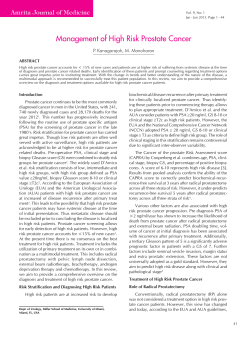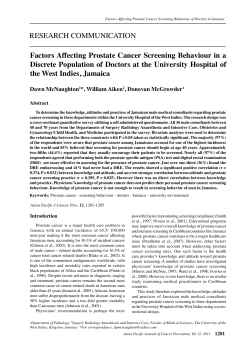
The Prostate Cancer Screening Controversy
The Prostate Cancer Screening Controversy Daniel J. Ricchiuti, M.D. St. Elizabeth Health Center Primary Care Update May 18, 2012 Overview Background Prostate Cancer and PSA Explore the controversy surrounding prostate cancer screening Present current data from randomized studies Discuss practical uses of PSA and prostate cancer screening in practice Question #1 If you are or were a male >50 years of age, would you check a PSA on yourself? NO YES UNSURE Question #2 Do you believe that prostate cancer screening effects your patients’ overall mortality? NO YES UNSURE Question #3 Do you believe that most of your patients desire to be screened for prostate cancer? NO YES UNSURE Prostate Cancer Assumptions Most common non-cutaneous cancer in males in U.S. Second leading cause of male cancer mortality >28,000 deaths expected in 2012 Natural history is heterogeneous and not clearly or consistently understood Gleason Scoring System Glandular architecture First number – most common pattern ex. 3 Second number – second most common pattern ex. 4 Gleason Sum – total of the two 3+4=7 Higher the sum the more aggressive the cancer Miscellaneous Information PCPT: Finasteride – 25% reduction in PCA diagnosis Those with PCA had more aggressive form 5 alpha-reductase inhibitors: 50% reduction in PSA value after 3 months SELECT Trial: Vitamin E – 17% more cases of PCA in those taking regularly Controversies Surrounding Prostate Cancer Does screening work? Is PSA a good screening test? Does early detection even matter? Does prostate cancer even need to be treated? Prostate Cancer Treatment Assumptions Surgery: Removes entire prostate gland Risk of incontinence, impotence, major complications Less invasive with robotic approach Prostate Cancer Treatment Options Radiation: More and more precise Destroys most of prostate Risk of impotence, burns, collateral damage to bladder, urethra, rectum External beam or brachytherapy Cryotherapy HIFU Prostate Cancer Risk Stratification Moderate to High Risk: PSA ≥ 10 Gleason Score ≥ 7 Low Risk: PSA < 10 Gleason Score ≤ 6 Prostate Cancer Risk Stratification Potentially Insignificant Cancer: <5% of 1 needle core involved Gleason 6 or less Low tumor volume Prostate Specific Antigen (PSA) Glycoprotein produced by epithelial cells of prostate Disruption of normal prostate architecture allows increased amounts into circulation: BPH Cancer Inflammation / infection Trauma Introduction in 1986 dramatically changed medical practice in U.S. PSA Interpretation No such things as “normal” PSA PSA is age and race dependent Age Caucasian African American 40 2.5 2.0 50 4.0 2.5 60 6.0 4.0 70 6.5 6.5 PSA As a Screening Test Responsible for profound stage migration toward earlier stages at diagnosis Advanced disease at presentation: 1988 = 19.2% 1998 = 4.4% Leads to overdetection and overtreatment of some patients PSA As a Screening Test Despite decrease in risk and stage of cancer at diagnosis, 90% of men choose some type of intervention when diagnosed To Biopsy or Not to Biopsy? Elevated PSA has been shown to affect patients mentally and physically even if the patient chooses not to have biopsy 4% risk of sepsis or bleeding with biopsy Importance of PSA Kinetics: PSA Velocity PSA Density PSA Doubling Time Individualized decision made with guidance from physician USPSTF on PCA Screening Population Recommendation Men Younger than Age 75 Years No recommendation Grade: I (Insufficient Evidence) Men Age 75 Years or Older Do not screen Grade: D Risk Assessment Prostate cancer is more common in older men, African Americans, and men with a family history of prostate cancer. The same uncertainties about the effects of screening that apply to other men also apply to these higher-risk men. Screening Tests The prostate-specific antigen (PSA) test is more sensitive than the digital rectal examination (DRE). The conventional PSA test cut-point of 4.0 g/L misses some early cancer. However, lowering the cut-point would increase the rate of false-positive results. Variations of PSA screening have not yet been demonstrated to improve health outcomes. Screening Intervals If PSA screening reduces mortality, screening every 4 years may be as beneficial as annual screening. Interventions Management strategies for localized prostate cancer include watchful waiting, active surveillance, surgery, and radiation therapy. There is no consensus regarding optimal treatment. Balance of harms and benefits •The harms of screening include the discomfort of prostate biopsy and the psychological harm of false-positive test results. •Harms of treatment include erectile dysfunction, urinary incontinence, bowel dysfunction, and death. A proportion of those treated, and possibly harmed, would never have developed cancer symptoms during their lifetime. For men younger than age 75 years, evidence is inadequate to determine whether screening improves health outcomes. Therefore, the balance of harms and benefits cannot be determined. Suggestions for practice For men age 75 years or older and for those whose life expectancy is 10 years or fewer, the incremental benefit from treatment of prostate cancer detected by screening is small to none. Therefore, harms outweigh benefits. Clinicians should discuss the potential benefits and known harms of PSA screening with their patients younger than age 75 years. Men in this age group should be informed of the gaps in the evidence, and their personal preferences should guide the decision of whether to order the test. USPSTF on PCA Screening A.U.A. Response: concern that recommendations will do more harm than good PSA does provide important information for diagnosis and risk assessment not all patients with PCA require treatment until there is a better test, USPSTF is doing a great disservice to men worldwide American Academy of Family Physicians 2008 “…insufficient evidence on which to make a recommendation for or against routine screening for prostate cancer using prostate specific antigen (PSA) testing or digital rectal examination (DRE)” Recommends against screening over age of 75 American College of Physicians No practice guidelines Mention of PSA controversy Referral to U.S. Preventative Services Task Force recommendations American Urological Association Revised Best Practice Policy in 2009 stating: …“early prostate cancer testing (PSA / DRE) should be offered to well-informed men, 40 years or older who have a life expectancy of at least 10 years.” American Urological Association Revised Best Practice Policy in 2009 stating (cont.): The decision to biopsy should be individualized based on PSA, DRE, age, race, comorbidities Not all prostate cancers require treatment and not all are fatal American Cancer Society “The ACS does not support routine testing for prostate cancer of this time” Health care professionals should discuss R&Bs of early prostate cancer detection and offer testing Start discussion at 50 unless increased risk for prostate cancer Men with < 10 year life expectancy should not be screened National Cancer Institute NCI does not have a recommendation about prostate cancer screening Referral to U.S. Preventive Services Task Force recommendations National Comprehensive Cancer Network (NCCN) Excellent discussion re: pros and cons for screening Baseline PSA and DRE is useful Careful examination of individual risk factors in considering biopsy March 26, 2009 NEJM Publication of the only 2 randomized trials concerning Prostate Cancer Screening: European Randomized Study of Screening for Prostate Cancer (ERSPC) Prostate, Lung, Colorectal, and Ovarian (PLCO) Both studies are ongoing European Randomized Study of Screening for Prostate Cancer (ERSPC) 162,243 men enrolled from 7 countries 9 year follow-up Screening group: various screening approaches Averaged PSA every 4 years Control group – no formal screening European Randomized Study of Screening for Prostate Cancer (ERSPC) 20% relative reduction in Prostate Cancer death with screening 1410 men would have to be screened and 48 treated to prevent 1 death from prostate cancer European Randomized Study of Screening for Prostate Cancer (ERSPC) Criticisms: Sextant biopsies were used Various criteria for biopsy used at different centers Different screening tools used at each center PSA vs. DRE Prostate, Lung, Colorectal, and Ovarian Trial (PLCO) 76,693 men enrolled – all from U.S. 10 study centers 7 – 10 years follow-up Screening Group – offered annual PSA for 6 years and annual DRE for 4 years Control Group – offered “usual care” Prostate, Lung, Colorectal, and Ovarian Trial (PLCO) Incidence of death from prostate cancer was the same in screening and control groups (2.0 vs. 1.7 deaths per 10,000 person years) Prostate, Lung, Colorectal, and Ovarian Trial (PLCO) Criticism: “PSA contamination” – about half of the subjects in the control had PSA testing by year 5 Control group not true control Anecdotal Patient Histories 53 yo WM Strong family history of prostate cancer PSA 1.2. Normal DRE Gleason 6 found on biopsy Treated with surgery Recurrent disease Anecdotal Patient Histories 65 yo AAM Longevity in family. Pt. very good health PSA 6.0. Normal DRE Prostate biopsy negative PSA rises at rate of 0.75 / year 4 prostate biopsies – all negative, sepsis and admission after 2nd biopsy Anecdotal Patient Histories 45 yo WM with back pain No family history of prostate cancer PSA 250. Bilateral firm on DRE Prostate biopsy – Gleason 5 + 4 = 9 Bone scan / CT Scan widespread metastatic disease Died 6 months after diagnosis Anecdotal Patient Histories 84 yo WM – very healthy PSA 12. Enlarged prostate on DRE Biopsy or no biopsy? Gleason 4 + 4 = 8 Treatment vs. observation Died of prostate cancer at 86 Question #4 If you are or were a male >50 years of age, would you check a PSA on yourself? NO YES UNSURE Question #5 Do you believe that prostate cancer screening effects your patients’ overall mortality? NO YES UNSURE
© Copyright 2025





















